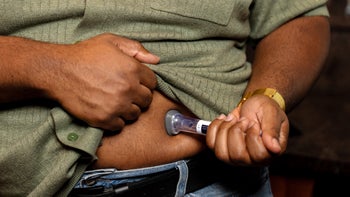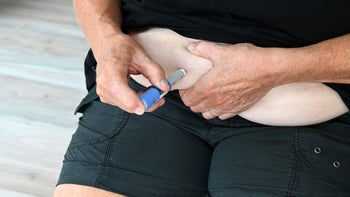
What Does It Feel Like to Take Mounjaro for Diabetes?
Key takeaways:
Mounjaro (tirzepatide) is a weekly injectable medication designed to help people with Type 2 diabetes lower their blood sugar.
For the best results, it should be used in combination with a nutritious diet and regular exercise.
People who take Mounjaro say it can have side effects like nausea and upset stomach, but it lowers appetite and helps with weight loss.
Access savings on related medications

Mounjaro — the brand name for tirzepatide — is an injectable medication that is FDA-approved to treat Type 2 diabetes.
If it’s used in combination with a diabetes-friendly diet and exercise, it can help people lower their blood glucose (sugar). It also lowers appetite, leading to weight loss. That has given Mounjaro the same kind of buzz as other medications with weight loss benefits — like Ozempic and Wegovy.
For people with diabetes who are unable to process glucose normally, Mounjaro is a relatively new non-insulin treatment. Here’s how three people describe what it feels like to take Mounjaro.
Search and compare options
Bad news set him on a healthy path
In August 2021, Gregory Boehnlein’s doctor took a look at his blood work and said: "Greg, you have full-blown Type 2 diabetes. If you don’t make some serious changes, you’re looking at some big trouble coming down the line.”
At 52, Gregory — who lives in Broadview Heights, Ohio and oversees the development of high-level business technology for Google — took the doctor's warning seriously.
“I have two daughters and a wife and two dogs and a busy career that I’m very happy to be a part of," he says. So, he committed to healthy eating and regular exercise after decades of being overweight and out of shape.
As a high school wrestler, he carried 220 pounds on his 5-foot, 11-inch frame. Over time, his weight crept up to more than 400 pounds.

A year after his diagnosis, he was still struggling. He persuaded his doctor to prescribe Mounjaro. In 2022, he says, on “November 1, I took my first dosage of Mounjaro. And I never looked back.”
“My side effects were very minimal. I had a little bit of nausea, I think two or three times.” The day after his weekly injection, he may feel mild lethargy. “I go exercise, and I feel better. I just push through it,” he says.
After taking Mounjaro, “I wasn’t interested in food.” he says. “Luckily for me, I am married to a dietician.”
Gregory's wife helped craft an eating plan that features lean protein and healthy fats, but no refined carbs. “I eat between 1,200 to 1,800 calories a day,” he says.
Within 6 months, his weight fell by 125 pounds. “I am completely off metformin because it was dropping my blood sugar too low,” he says. While the risk of hypoglycemia (low blood glucose) is low while taking Mounjaro, the risk goes up the more diabetes medications you take.
“One of the things that's probably saved me is that I am an avid backpacker and hiker,” Gregory says. “I like to do outdoor things. If you can imagine a 400-pound guy going on the Appalachian Trail for 300 miles, that’s me.”
Now, “I’m back out on a mountain bike, which I never thought I would do again. I mean, it’s been 30 years, and I’m addicted. I can’t stay off the trail,” he says. “I kind of hacked my body, I guess, to [have] much more of an athlete’s metabolism.”
Another factor in Gregory's program is strict record-keeping, including “regimented tracking of every calorie that went in my mouth. I’m a technology kind of guy, obviously.” Tracking the data helps him stay on course. Not long ago, he rewarded himself for his progress with a special mountain bike.
Gregory's discipline even impressed his skeptical doctor. “He has no bedside manner. But he listened. He bet $200 that I wouldn’t get my levels to a specific, pretty aggressive goal.”
Not long ago, the doctor paid off on his bet. “When your doctor is paying you, it doesn’t matter if he has bedside manner,” Gregory says. “He’s completely turned around. He’s become a cheerleader for me.
Gregory uses social media to advocate for people with diabetes and others struggling to rebuild their health.
“I’ve been very active on the Reddit forums sharing my story with people, encouraging them to eat right, diet, and exercise. I just want to pay it forward because it is life-changing,” he says.
Gregory says the process also requires “a lot of empathy for yourself” as a larger person. “People don’t understand if they’ve never had to deal with a weight problem. They just don’t understand the depression and the embarrassment and all of the things that society throws at you.”
His most important message, he says, is that “Mounjaro was part of the solution, but it’s not the drug alone,” he says. “The drugs are not going to solve your problem if you don’t make significant changes.”
He says this ‘miracle drug’ is worth paying out of pocket
Jeff Capron, a 53-year-old web developer from Boonville, New York, started taking Mounjaro in December 2022. A friend reported good results with the medication, so Jeff looked into the research studies behind it, then spoke with his primary physician.
“He said, ‘Yeah, let’s give it a shot.’ He didn’t have much experience with it. He didn’t have an opinion one way or the other, other than looking at the data set, and seeing no reason why we couldn’t try it.”
Jeff's hemoglobin A1C went from 10.1% to 6% in 3 months. “Which is really good,” he says. “I’d never had that kind of experience with any medication for diabetes.” There’s a range when it comes to how much A1C reduction people experience with Mounjaro. But many people taking it are able to get their A1C under 7% — an ideal goal for people with Type 2 diabetes.
Early on, Jeff experienced some constipation, and a little trouble sleeping. But both issues went away quickly. Now, he says, “I wake up in the morning, and my fasting blood sugars are pretty much normal.”
The medication took effect, he says, within 12 hours. He compared the feeling to having a gastric bypass. “Basically, you can’t eat too much food. As soon as you eat a little bit too much, you almost feel ill.” While it generally takes a few months to notice effects like A1C reduction and significant weight loss, side effects like lower appetite may be felt right away.
Weight loss was not his primary goal, but he lost about 35 pounds in the first 5 months on the medication. He also lost his sweet tooth. “I can maybe count three sweet things I’ve eaten since December.”
Jeff found his appetite slowly recovered days after taking Mounjaro. “You take the shot every Sunday, and by Saturday you start to get a lot of appetite,” he says. “It doesn’t seem to affect your weight. If I eat a little bit more on Saturday night, on Sunday, the scale hasn’t really moved one way or the other.”
Jeff is allergic to hornets, so he already carries an auto-injector. He wasn’t worried about using another drug that was delivered through a needle. “It’s just a push button," he says. It also helped that his wife is a nurse. “So, I had her with me the first time, to make sure I was doing it right. I didn’t even feel it.”

When Jeff was first prescribed Mounjaro, his insurance covered it. The company has since removed that benefit. He has filed an appeal, but meanwhile pays about $1,000 a month out of pocket for his weekly injections. He plans to keep paying as long as necessary.
He considers the financial burden well worth it. “I’ve never had a medication that worked as well before for chronic conditions,” Jeff says. “I’ve been blown away by it. For me, it’s a miracle drug. It basically got rid of my diabetes.”
First responder checked the research
Brendan McGurk’s doctor was concerned. The 38-year-old Minneapolis flight paramedic had been taking insulin and metformin for years to control his diabetes. But when his blood tests showed “progressively worsening insulin resistance,” he says, his physician looked to Mounjaro for help.
Brendan researched the scientific data behind the medication and the “mechanism of action of the drug.” What he found, he says, “was certainly very encouraging.”
Things went smoothly from the start, he says. “I got a relatively benign course. It worked very well for me.”
Unwelcome effects were negligible, Brendan says. “I really didn’t have any side effects. I mean, every once in a while, maybe a little bit of nausea. It’s very mild if it ever occurred, so I just went through it. Generally speaking, I would say no side effects whatsoever.”
More importantly, he saw an immediate reduction in his blood glucose levels and improvement in his A1C, and a reduction in the amount of insulin he needed.
Brendan says as a first responder he is also happy that he’s “been able to maintain [good glucose] pretty consistently at the same dose.” That indicates his condition is very stable, a goal for all people with diabetes, and doubly so for people in high-stakes jobs, such as first responders.

“I generally didn’t feel poorly before,” Brendan says, “but I feel absolutely great now. And I’ve had improved control [of blood glucose]. Other than setting a reminder to do it the same day every week, I really didn’t have any issues.”
The injections have not had an effect on his ability to exercise, either, Brendan says. “I have kind of a weird schedule. Shift work kind of messes with your energy levels at baseline, but I haven’t noticed any difference with the Mounjaro.”
Aside from the physical activity required for his job, Brendan says his canine companion helps, too. “I just make a point of going out with my dog quite a bit, walking her.”
Insurance covers his prescription, but he says growing demand for Mounjaro means there have been occasional hurdles.
“I have had some periodic delays in getting it just because of supply-side issues, where Walgreens might not have it for a few days,” he says. “But in general, I haven’t had any issues.”
Brendan is not expecting to stop using the medication any time soon. “As far as I know,” he says, “I think it’s something I stick with as long as I need it. I’ve had good results myself, and evidence seems to support it pretty heartily.”
What does the pharmacist say?

Christina Aungst, PharmD
Pharmacy Editor
Mounjaro (tirzepatide) has been a game-changer for people living with Type 2 diabetes. This is especially the case for people who also have obesity. This once-weekly injectable medication has blown many other diabetes medications out of the water — both because of its A1C reduction and weight loss benefits.
On average, people taking Mounjaro for a year experience about a 2% to 2.5% reduction in A1C. However, between 75% and 85% of people in clinical trials achieved an A1C of less than 7% — a common goal for many people with diabetes.
Mounjaro’s weight loss potential is impressive. In clinical trials, people with diabetes taking the highest dose experienced an average of a 15.7% body weight reduction. And more than one-third of participants reported more than a 20% weight loss. Keep in mind that Mounjaro isn’t FDA-approved for weight loss yet. But it’s expected that the agency will approve it for this use in the near future.
When it came to market, it became the first in a new class of medications: a dual glucose-dependent insulinotropic polypeptide (GIP) and glucagon-like peptide-1 (GLP-1) receptor agonist. It works by mimicking two gut hormones, GIP and GLP-1. These hormones play a role in how we digest food and regulate blood glucose after eating. But they also play a role in making us feel fuller and curbing food cravings.
Mounjaro has a number of potential side effects. Most commonly, people experience nausea or vomiting, diarrhea, and lowered appetite. For many people, these effects are mild and can be managed at home. They’re typically most noticeable when first starting the medication, or shortly after raising the dose. They should get better or resolve as your body adjusts to it.
The risk of hypoglycemia (low blood glucose) is very low if Mounjaro is the only diabetes medication you’re taking. But if you also take other medications — particularly insulin — the risk of this side effect goes up. Be sure to discuss how to recognize and treat hypoglycemia with your healthcare provider if you’re adding Mounjaro to an existing diabetes medication regimen.
Why trust our experts?



Was this page helpful?
Related Articles
Browse medications
View AllResearch prescriptions and over-the-counter medications from A to Z, compare drug prices, and start saving.




























